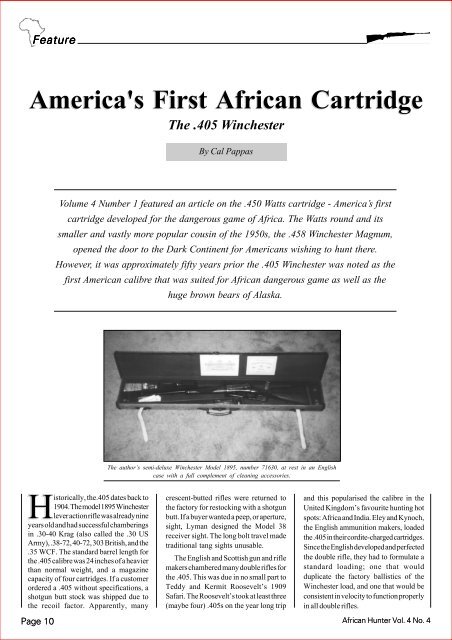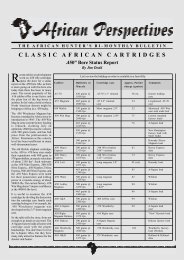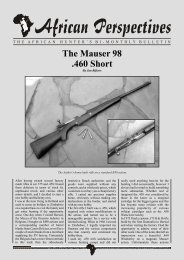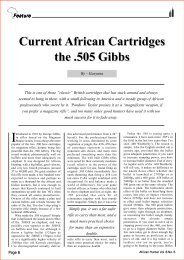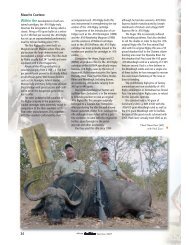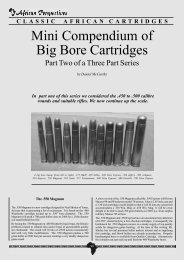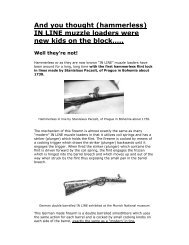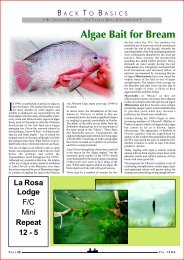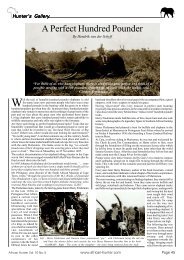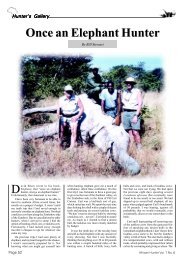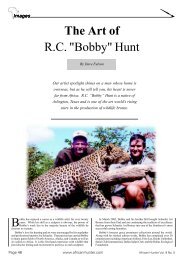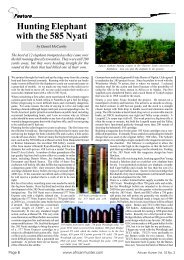America's First African Cartridge Feature - HuntNetwork
America's First African Cartridge Feature - HuntNetwork
America's First African Cartridge Feature - HuntNetwork
You also want an ePaper? Increase the reach of your titles
YUMPU automatically turns print PDFs into web optimized ePapers that Google loves.
<strong>Feature</strong><br />
<strong>Feature</strong><br />
<strong>America's</strong> <strong>First</strong> <strong>African</strong> <strong>Cartridge</strong><br />
H<br />
Historically, the.405 dates back to<br />
1904. The model 1895 Winchester<br />
lever action rifle was already nine<br />
years old and had successful chamberings<br />
in .30-40 Krag (also called the .30 US<br />
Army), .38-72, 40-72, 303 British, and the<br />
.35 WCF. The standard barrel length for<br />
the .405 calibre was 24 inches of a heavier<br />
than normal weight, and a magazine<br />
capacity of four cartridges. If a customer<br />
ordered a .405 without specifications, a<br />
shotgun butt stock was shipped due to<br />
the recoil factor. Apparently, many<br />
Page 10<br />
The .405 Winchester<br />
By Cal Pappas<br />
Volume 4 Number 1 featured an article on the .450 Watts cartridge - America’s first<br />
cartridge developed for the dangerous game of Africa. The Watts round and its<br />
smaller and vastly more popular cousin of the 1950s, the .458 Winchester Magnum,<br />
opened the door to the Dark Continent for Americans wishing to hunt there.<br />
However, it was approximately fifty years prior the .405 Winchester was noted as the<br />
first American calibre that was suited for <strong>African</strong> dangerous game as well as the<br />
huge brown bears of Alaska.<br />
The author’s semi-deluxe Winchester Model 1895, number 71630, at rest in an English<br />
case with a full complement of cleaning accessories.<br />
crescent-butted rifles were returned to<br />
the factory for restocking with a shotgun<br />
butt. If a buyer wanted a peep, or aperture,<br />
sight, Lyman designed the Model 38<br />
receiver sight. The long bolt travel made<br />
traditional tang sights unusable.<br />
The English and Scottish gun and rifle<br />
makers chambered many double rifles for<br />
the .405. This was due in no small part to<br />
Teddy and Kermit Roosevelt’s 1909<br />
Safari. The Roosevelt’s took at least three<br />
(maybe four) .405s on the year long trip<br />
and this popularised the calibre in the<br />
United Kingdom’s favourite hunting hot<br />
spots: Africa and India. Eley and Kynoch,<br />
the English ammunition makers, loaded<br />
the .405 in their cordite-charged cartridges.<br />
Since the English developed and perfected<br />
the double rifle, they had to formulate a<br />
standard loading; one that would<br />
duplicate the factory ballistics of the<br />
Winchester load, and one that would be<br />
consistent in velocity to function properly<br />
in all double rifles.<br />
<strong>African</strong> Hunter Vol. 4 No. 4
Today, prior-owned plain grade boxlock<br />
double rifles in .405 can be purchased for<br />
USD6-9000, with higher quality sidelocks<br />
costing upwards of twice that. They can<br />
be found from most of the English and<br />
Scottish makers.<br />
The .405 rapidly gained fame and was<br />
used by some of the best known and<br />
proficient hunters of the early 1900s.<br />
Without doubt, Teddy Roosevelt’s praise<br />
of the calibre was its best endorsement.<br />
Well-known as a conservationist,<br />
Roosevelt nearly doubled the size of<br />
America’s national parks and developed<br />
over 50 wildlife refuges. In March of 1909<br />
Teddy put up enough supplies to spend<br />
a year in Africa. He chose not to seek a<br />
third term in office but felt secure with<br />
William Howard Taft as the President;<br />
Taft promising to carry on with<br />
Roosevelt’s progressive domestic and<br />
economic programmes. (That was not to<br />
be, and Teddy developed the Bull Moose<br />
party to later unseat Taft. The Republican<br />
vote in the 1912 election was now split<br />
and the victor was the Democrat, Wilson).<br />
Always having a love of fine firearms,<br />
Teddy ranched and hunted the Badlands<br />
of the Dakotas in the 1880s with, among<br />
others, a .45 Colt Single Action Army<br />
revolver, a .45-75 Winchester Model 1876,<br />
another ’76 in .40-60. a .45 calibre Sharps,<br />
and an English double rifle in .500 Express.<br />
Later, he was to state his favourite rifle<br />
was the .45-90 Model 1886. For his 1909<br />
safari, Teddy’s rifles were a .30 calibre<br />
Springfield which he "...stocked and<br />
sighted to suit myself,” a .500/450 Holland<br />
Nitro Express double rifle, and a Model<br />
1985 in .405. The double rifle was given to<br />
him by a group of English hunters and<br />
conservationists. This big stick of<br />
Teddy’s was recently sold at auction for<br />
a half-million dollars.<br />
The big double, however, did not push<br />
the .405 out of Teddy’s safari picture. “I<br />
cannot say how much I like these two .405<br />
rifles you sent me. Now, my belief is that<br />
in Africa those will be the two rifles my<br />
son and I will habitually carry in our own<br />
hands; the rifles upon which we will most<br />
depend”, Teddy wrote to the Winchester<br />
company before his departure. He did<br />
send at least one .405 back to the company<br />
for the rear sight to be adjusted to his<br />
liking.<br />
Roosevelt’s safari began as a<br />
$75 000(US) expedition (over one million<br />
in today’s dollars). When he ran short of<br />
money, he wired Andrew Carnegie for an<br />
additional $30 000. Carnegie replied to<br />
“rest easy”, that he would take care of the<br />
need. Scribner’s magazine paid Roosevelt<br />
$50 000 for his story, with an additional<br />
20% royalty on the book (a first edition<br />
sits on my desk as I pen this). And it was<br />
in Scribner’s, and other books and<br />
magazines, that Winchester received some<br />
of its finest advertisements. Hunting with<br />
Lesile Tarlton, one of the best<br />
professionals of the day, Roosevelt<br />
commented. “Tarlton took his big double<br />
barrel and advised me to take mine, as the<br />
sun had just set and it was likely to be<br />
close work; but I shook my head, for the<br />
Winchester .405 is, for me personally, 'the<br />
medicine gun' for lion”.<br />
Lion were not the only game that fell to<br />
Teddy’s .405. Rhino and elephant fell too,<br />
as did lesser game, but Teddy preferred<br />
the heavy double for the thick skinned<br />
pachyderms. Of the 4 900 mammals and<br />
2 000 reptiles (plus 4 000 birds and 500<br />
fish) Teddy and Kermit sent to the<br />
Smithsonian Museum, many were taken<br />
with the .405. His son, Kermit also hunted<br />
with a .405.<br />
The .405 rapidly gained<br />
fame and was used by<br />
some of the best known<br />
and proficient hunters of<br />
the early 1900s.<br />
Charles Cottar, the first American to<br />
become a professional hunter in Africa<br />
(1909), chose a .405 as his rifle. This was<br />
a replacement and a better choice than the<br />
.32 Special Model 1894 he brought with<br />
him from his native Oklahoma. Hunting is<br />
a rough and dangerous profession and<br />
Charles was mauled by a leopard three<br />
times, gored by a buffalo, run over by an<br />
elephant in his career, and later partially<br />
paralysed by a stroke. He died in 1940<br />
when his .405 failed to stop a charging<br />
rhino that he shot twice. The rhino gored<br />
Cottar’s femoral artery and he bled to<br />
death along with being crushed as the<br />
dying beast fell on him. As his son raised<br />
a canvas to protect him from the hot sun,<br />
he refused, stating, “No, I want to see the<br />
sky” with his last breath.<br />
In Stewart Granger’s greatest film, and<br />
perhaps the best film on Africa, King<br />
Solomon’s Mines (1950), Granger finds<br />
the rifle of an explorer he has been tracking.<br />
It is a battered Model 1895 with a 24"<br />
barrel he finds on a pile of rocks in<br />
uncharted country with a message carved<br />
into the stock: “Ammunition gone,<br />
heading NW, inform Elizabeth Curtis, 73<br />
Grosvenor Sq., London. Henry Curtis.”<br />
The actual calibre of the rifle is not<br />
mentioned, but it makes a statement that<br />
the Model ’95 was an <strong>African</strong> rifle.<br />
In the late 1920s, Mr Hurlburd Johnston<br />
and a friend went on safari in Ceylon.<br />
Johnston purchased a used .405 for $25<br />
and proceeded to take buffalo, crocodile,<br />
wild boar and antlered game. He spoke<br />
highly of the performance of the rifle and<br />
calibre.<br />
During the same decade, Martin and<br />
Osa Johnson lived a life of adventure in<br />
Africa and the jungles of Asia and the<br />
Pacific Islands. They chronicled their<br />
experiences in several books and carried<br />
a .405 Winchester with them. “When we<br />
got back to camp she (Osa) had the bullet<br />
cut out to prove that it was my .405 that did<br />
the trick, and not her Springfield (.30-06).”<br />
Belgian hunter Dr. Robert Danis,<br />
speaks quite favourably on the .405 and<br />
other Winchesters in Africa. His 1908<br />
safari in French Central Africa with some<br />
friends put Winchester’s smallest big bore<br />
to a good test. He states the gun was<br />
“...superior to everything by strength,<br />
accuracy, killing power, (and) quick and<br />
easy shoulder repetition...” Danis’ .405<br />
printed two-inch groups at 100 yards, had<br />
“reasonable” recoil, and he stated full<br />
patch bullets must be used for elephant.<br />
Four .405s performed on this safari and<br />
one, used by a woman hunter, was quick<br />
to drop a rhino.<br />
The .405 enjoyed popularity in the<br />
States, too. Perhaps the largest brown<br />
bear taken (body size, not skull size) was<br />
shot by Alaska adventurer and pilot Bob<br />
Reeve on the Alaskan Peninsula at Cold<br />
Bay in 1948. Taken at a distance of 275<br />
yards with an open sighted .405, the bruin<br />
measured 12 feet from front paw to front<br />
paw across the shoulders. A bear this size<br />
would have weighed well over 1800<br />
pounds! And, with this being a spring<br />
bear, by fall it could have weighed nearly<br />
a ton!<br />
American hunter James Purdy wrote,<br />
“For shooting elk in thick, brushy and<br />
timbered country, the .405 shows up a<br />
great advantage, as it is as good a brush<br />
cutter and carries enough weight and<br />
shock... If I could have but one rifle for big<br />
game hunting, I would surely choose my<br />
.405”.<br />
Elmer Keith, arguably the high priest of<br />
American gun writers, had this to say<br />
about the .405 when hunting elk: “...none<br />
of them went over 200 yards... they are<br />
<strong>African</strong> Hunter Vol. 4 No. 4 Page 11
simply too sick from the impact of the heavy<br />
slug to travel.”<br />
Townsend Whelen, who was a strong<br />
advocate of the .30-60, stated the .405 was<br />
the best American cartridge for bear and<br />
moose. He stated of all the common hunting<br />
cartridges available, the .405 would be the<br />
least to require a second shot on big game.<br />
Not all agreed on the effectiveness of the<br />
.405. John ‘Pondoro’ Taylor wrote in his<br />
<strong>African</strong> Rifles and <strong>Cartridge</strong>s that the<br />
“.405’s calibre compels it to be included in<br />
this group (.40 calibre), though it does not<br />
otherwise deserve to be”. He goes on to<br />
write the sectional density is “none too<br />
good” and it “lacked penetration on all the<br />
larger species”. Taylor believed Roosevelt<br />
had his professional hunter, R.J.<br />
Cunningham, back him up with a large calibre<br />
rifle when Teddy was shooting lion with his<br />
Winchester. In closing, Taylor says “I would<br />
not advise anybody to invest in a .405 if they<br />
can get anything else for <strong>African</strong> hunting.”<br />
Ballistically, the .405 can be as simple, or<br />
as complex, as one likes: the straight case<br />
makes down loading easy for target shooting.<br />
To begin with factory ballistics, the 1916<br />
Winchester catalogue lists the .405 with a 300<br />
grain bullet at a muzzle velocity of 2204.4 fps<br />
for an energy figure at the muzzle of 3236.6<br />
ft.lbs and a figure of 38.8 for Taylor’s knock<br />
out value. To compare, the .375 H&H knock<br />
Page 12<br />
out value is 41 with<br />
a muzzle energy of<br />
approximately 1000<br />
ft.lbs more than the<br />
.405. (The calculation<br />
for KO value is<br />
bullet weight x bullet<br />
diameter x velocity<br />
divided by 7000 - see<br />
following article<br />
for full description)<br />
A sample of .405<br />
loadings with American<br />
powders:<br />
Winchester's Model 1895 in<br />
Manton's catalogue.<br />
Winchester Repeating Rifle, Model 1895.<br />
TR, the .405, and a lion.<br />
Photo: <strong>African</strong> Game<br />
Trails.<br />
weight weight feet/sec<br />
bullet grains powder grains velocity source<br />
cast .................... 290 ............... 2400 ................. 25 .................... 1500 ..................... Lyman<br />
cast .................... 290 ............... 2400 ................. 32 .................... 1850 ..................... Lyman<br />
cast .................... 290 .............. hi-vel ................. 40 .................... 1704 ..................... Lyman<br />
cast .................... 290 .............. hi-vel ................. 53 .................... 2200 ..................... Lyman<br />
cast .................... 290 ............... 3031 ................. 40 .................... 1500 ..................... Lyman<br />
cast .................... 290 ............... 3031 ................. 45 .................... 1775 ..................... Lyman<br />
cast .................... 290 ............. unique ................. 16 .................... 1460 ..................... Lyman<br />
jacketed ............. 300 ............... 2400 ................. 32 .................... 1840 ..................... Lyman<br />
jacketed ............. 300 ............... 2400 .............. 34.4 .................... 1940 ..................... Lyman<br />
jacketed ............. 300 .............. hi-vel ................. 40 .................... 1695 ..................... Lyman<br />
jacketed ............. 300 .............. hi-vel .............. 53.4 .................... 2260 ..................... Lyman<br />
jacketed ............. 300 ............... 3031 ................. 45 .................... 1750 ..................... Lyman<br />
jacketed ............. 300 ............... 3031 ................. 57 .................... 2250 ..................... Lyman<br />
jacketed ............. 300 ............... 4320 ................. 52 .................... 1905 ..................... Lyman<br />
jacketed ............. 300 ............... 4320 ................. 62 .................... 2220 ..................... Lyman<br />
Sporting Rifle, Model 1895, .30 Government<br />
Models 1903 And 1906, .35 And .405 Winchester.<br />
Twenty-four Inch Round Nickel Steel Barrel, Weight about 8 1 /2 pounds, Magazine Capacity 4.<br />
My favourite loads are:<br />
1) Target: 45 to 50 grains of 3031<br />
powder and a 300 grain cast gas check<br />
bullet.<br />
2) Hunting: 57 grains of 3031 and a 300<br />
grain Barnes bullet. .032" jacket for general<br />
hunting and .049" jacket for dangerous<br />
game.<br />
I have done limited work developing a<br />
load with a 400 grain solid or soft point<br />
bullet when I return to Zimbabwe for<br />
buffalo. Average velocities are as follows<br />
using 3031 powder: 40 grains = 1500fps.,<br />
45 grains = 1675fps., 50 grains = 1875fps.<br />
I plan to try slower powders such as 4831,<br />
but the work is not complete as this goes<br />
to print.<br />
Since factory ammunition is<br />
unavailable, handloading is the only way<br />
to go. It was the hope of every .405 fan that<br />
Browning would chamber their Model<br />
MODEL<br />
1895<br />
The .405 was Winchester’s big game<br />
calibre in 1916.<br />
<strong>African</strong> Hunter Vol. 4 No. 4
1985 in .405, thereby<br />
prompting factory<br />
loaded ammunition<br />
from one or more of<br />
the major manufacturers.<br />
However,<br />
this was not to be.<br />
Jacketed bullets<br />
can be purchased<br />
from Barnes Bullets<br />
in several varieties:<br />
spitzer, semi-spitzer,<br />
and round nose, in<br />
jacket thickness of<br />
.032 and .049", in 300,<br />
350, 400 grains. Solids<br />
of 350 grains and 400 grains are available<br />
also, as well as Barnes’ famous X bullet. A<br />
low velocity target and plinking load can be<br />
used with 41 calibre handgun bullets of 210<br />
grains at 1000 to 1200 feet per second.<br />
Cast bullet moulds can be purchased<br />
from LBT of Moyie Springs, Idaho and<br />
NEI of Portland, Oregon. Antique moulds<br />
(for the purists) of Winchester or Lyman<br />
make, may be located through collectors.<br />
Wheelweight alloy is satisfactory for those<br />
not wanting to go to the time and trouble<br />
to mix batches of tin, lead, and antimony,<br />
and is suitable for velocities under 1600<br />
fps. Drop the hot bullet from the mould<br />
into a bucket of room temperature water<br />
and 2300 fps is possible with gas-checked<br />
bullets, lubed with LBT Commercial Blue<br />
bullet lube. It will take 24 hours for the<br />
hardness of the lead to come up to<br />
specifications, so wait a day before using<br />
a lead hardness tester.<br />
Manton’s 1927<br />
catalogue featured a<br />
double rifle<br />
chambered for the<br />
.405.<br />
Brass cases can be made by stretching<br />
.444 Marlin brass or blowing out and<br />
stretching .30-40 Krag cases to the correct<br />
length of 2.583 inches. Robert Pomroy of<br />
Corinth, Maine has been my supplier in<br />
the past. .30-40 Krag cases seem to work<br />
best in my rifle. However, the primer pockets<br />
loosen after a few loads at full throttle. It<br />
may be possible to find BELL brass in .405<br />
basic and trim to length. Due to the<br />
excessive amount of brass that needs to<br />
be removed, I would suggest a power<br />
case trimmer from one of the major<br />
manufacturers.<br />
Primers and Powder are readily<br />
available, but may I suggest magnum<br />
primers? While they may not be needed,<br />
I use them to ensure maximum powder<br />
ignition in all my shooting, but I drop the<br />
powder charge one-half a grain on<br />
maximum loads.<br />
MATETSI WILDLIFE<br />
2/5P<br />
F/C<br />
REPEAT 4 - 3<br />
(STEWPOT)<br />
Gas checks for 40 calibre are available<br />
from Lyman and reloading dies can be<br />
purchased from RCBS and CH Tool.<br />
Because of the popularity of the .40<br />
calibre in the C. Sharps single shot rifles,<br />
both C. Sharps Arms and Shiloh Sharps in<br />
Big Timber, Montana, are excellent<br />
sources for moulds, gas checks, and brass<br />
as well as other reloading and shooting<br />
supplies for the 40 calibres.<br />
My personal .405 is a semi-deluxe model<br />
with sling eyes, checkering, recoil pad,<br />
and above average wood but lacking any<br />
burl quality. The bore is near perfect and<br />
an unusual rear sight was married to the<br />
barrel long ago. The shotgun butt and recoil<br />
pad decrease the felt recoil a great deal.<br />
The original recoil pad was hard as a<br />
rock and in very poor condition. The<br />
excellent gunsmiths of Griffin and Howe<br />
in Bernardsville, New Jersey replaced it<br />
with a correct solid rubber pad with a<br />
leather cover. The underside of the original<br />
pad had the following: “Jun 14, 1912” was<br />
stamped in ink and “W.K. 7.20.12” was<br />
hand printed in ink. The dates on the<br />
recoil pad are two years prior to the 1914<br />
production year of the rifle.<br />
PLEASE NOTE: Since Mag-Set<br />
Publications and the author have no control<br />
over the use of the loading data listed in this<br />
article, or of the condition of the firearms it<br />
may be used in, Mag-Set and the author<br />
disclaim any responsibility for use thereof. The<br />
author has only used a few of the loads listed<br />
here in his personal rifle so it is also the<br />
responsibility of the reader to check the<br />
original references of the loading data.<br />
<strong>African</strong> Hunter Vol. 4 No. 4 Page 13


